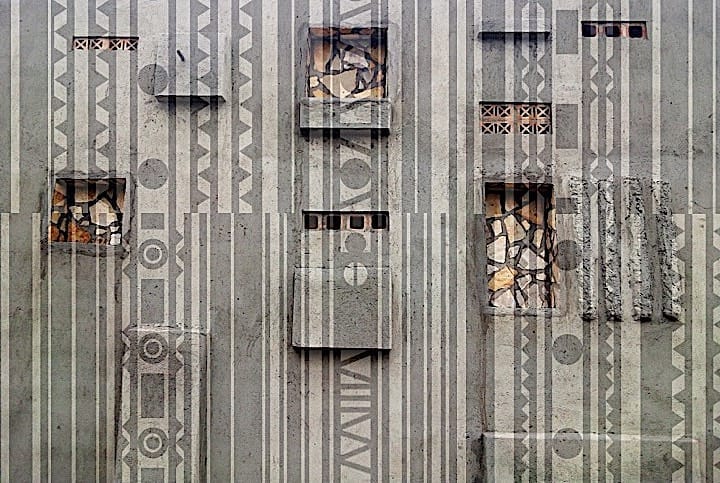Collin Sekajugo and the Collective Visage.
Collin Sekajugo has practiced in many spaces globally and here in East Africa, he has run art initiatives in Rwanda and Uganda, in conversation with him when I asked what drove him he replied that it is the question of visual identity, he posits that our neighbors have identifying features about them, the Kenyans have the Masai beads, the Tanzanians have co-opted Tingatinga but what does Uganda have? We have had visionaries try to create distinct visual styles like Owekitiibwa Nuwa Wamala Nyanzi with the silhouetted figures on various patterned and gradient backgrounds, but those figures still are close to the simple abstraction of the human figure, the “originality” of these is not the issue to contend with, the exploration is into why there seem to be no internal influences on the visual aspects of local contemporary image making from the past, do we not have an art history? Is it repressed? The wide abstracted style can not be attributed to a singular creative output, it is from observation.

This is not to say we don’t have original images being created by artists today, I believe we do. The challenge lies in part to how art pedagogy is structured and its origins, most of the artists at the beginnings of contemporary art who were formally trained studied at Margaret Trowell School of Industrial and Fine Art under the stewardship of Margaret Trowell who in her work aimed to educate indigenous artists to rise from creating objects out of bare utility and for them to begin thinking about aesthetic qualities in their work, for her to accomplish this there were two ways; the first immerse herself in the visual culture of the native artists and collaborate on structuring a syllabus based on local forms of image making or the second; superimpose European image making as a reference point for aesthetic ways of seeing, her choice was the second.
“It is here, in relation to the teaching of figurative arts ‘not native’ to East Africa, that the concern first emerges, within Trowell’s texts, about the extent to which these art works, produced by African students under the instruction of a European teacher, trained in Europe, might be distinguished from those produced by artists or art students of European extraction. Her writing articulates a strong desire for this ‘new art’ to bear little or no European resemblance – even though, as she understood it, her students’ work had no indigenous aesthetic antecedents, and even though the form, the materials and the media had effectively all been introduced by her. “ (Wanambwa, 2014) *
Then where does this leave an art history founded on an “inclusion” in an art history that decidedly puts the inhabitants of it on the outside, the discourse we built local contemporary art on was based on medieval European approaches and influences,

“In advocating for the elevation of craft and craftsmanship as the soundest route to a civilized life in East Africa, Trowell repeatedly cited medieval Europe, “where small groups of people were self-supporting and yet where civilization reached a high standard” as her inspiration and her example.” (Wanambwa, 2014)
So where does this leave an art history that has a reference point rooted in Europe, artists have not engaged with local critical (culturally) discourse until recently, most artists until this point have only engaged with critical discourse in an effort to explain (to the west) that the local is capable of the sublime an in fact has the ability to conceptualize and complicate reality, this has been achieved mainly through image making rooted in a series of references of western artistic discourse, visual and theoretical, one may ask for an example of this and I may offer this, if one examined local cultural production in Uganda and the crop of what are hailed as the leading contemporary artists you’ll notice that their image making started out from timid experimentation as all art starts out from but more and more for the artist’s work to succeed it had to be more in line with the prevalent “universal” image making, the structure and symbolism has to be familiar enough for the patronage to associate with the work.
The problem with this is that it in a way obfuscates origins so much so that one is eternally living at least locally in an everlasting aesthetic intervention that finally dissolves into a reluctantly accepted but not necessarily understood success, the audience must learn these new “universal” visual languages, the ones handed to them by the ancestors do not possess enough to conceptually contend with the new digital global dispensation, of course this is not true it would only take more work and commitment to the appropriation of older local ways of seeing.
This is what Collin Sekajugo is aiming for in his practice; to abstract and work with in innately primal and indigenous symbols, and I say indigenous because the symbols he plays with are at the stage image making was locally before aesthetic prescriptivists rained downed with figuration styles, the renaissance, cubism and others, Collin now builds from these and adds self-portraiture and sometimes indigenous models as a means of tying it all together, this becomes the anchoring point of these symbols and the interaction is now reversed, the art work is familiar to both the native and the universal patronage because both can now recognize the indigenous in the work without the aid of textual and visual referencing to “universal” discourses, Sekajugo succeeds at abstracting the sublime of the indigenous using a language that belongs to them.
* Margaret Trowell’s School of Art. A Case Study in Colonial Subject Formation, Emma Wolukau-Wanambwa DOI 10.4472.9783037346808.0008
Cover Image from Heremagazine